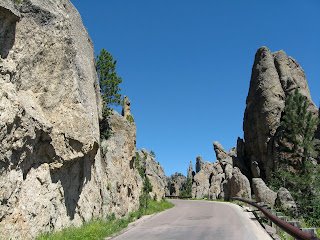I had a touristy vacation weekend (hence lots of photos!) in the Black Hills with Joan Nelson, my generous host in her big, all-year house in Rushville, Nebraska, and her getaway R&R trailer in Custer, South Dakota. The Black Hills are home to Mt. Rushmore, the gold rush of the Black Hills of 1874-77, the Crazy Horse Monument (ongoing & slated to be the biggest mountain carving in the world), beautiful scenery, and a state park with a safari-type wildlife driving loop.
The elevation in the Black Hills is around 6,000 ft, higher than a mile, and the ancient mountain range used to be taller, now worn away with age to the hardest layer -- granite (which is at least part of why this site was chosen for Mt. Rushmore, to be built out of the hard granite that doesn't easily wear away). The Black Hills are unexpected -- a ribbon of mountains among flat plains and low, gently rolling hills. And they're beautiful, covered in pine, with some naked granite patches, and beautiful and expansive rock formations called the Needles and the Cathedral.
This rock is called the Needle's Eye and about two and a half of my lengths would fit into "the eye."
In a few places the road goes through wonderfully tiny tunnels.
These formations -- expansive and majestic -- are called "The Cathedral," and they really look it.
The Black Hills, or Pahá Sápa in Lakota (literally, Black Hills), are also sacred land to the Lakota, the place where the creation story tells of their beginnings. It is land that by treaty belongs to the Lakota people, settled illegally by the gold seekers in the late nineteenth century (even the U.S. army initially tried to put up a fight against the gold rushers, trying to protect Lakota land), and, through a number of equally illegal government maneuvers, was finally taken away from the Lakota people for good. Sometime in the 1980s, I think, the government finally offered $106 million to compensate for the loss of the land to the Lakota tribe, but they rejected it, insisting that the land be given back. It hasn't happened yet.
So places like Mt. Rushmore, while being a hugely important and emotional symbol of patriotism for many, is also a violation -- of the land and of American legal agreements with the Lakota. Nevertheless, we did the requisite site-seeing, and here's the photographic proof:
And this is Joan's lovely, absolutely quiet and isolated place where I got to stay while in the Black Hills:
Joan's man-made pond, with a turkey vulture hanging out on the other side.
Small meadow before the forest behind the trailer. The indentations are where deer sleep!
Another view of the deer beds.
Intertwined ponderosa pine trees.
Turkey vultures in the tree tops towards the top of the hill behind the house. They're vultures that have red heads like turkeys.
The forest deck that Joan's neighbors built. The seats fold into a table and a bed! The neighbors are quite an amazing couple -- a Methodist pastor who is also a rock and mineral expert, a funny and knowledgeable and adventurous, independent, opinionated lady; and her husband, quiet and smiling, expert builder who built by himself, in his 60s, this deck, as well as a sprawling, fancy house down the hill that serves as their home and as a spiritual and nature retreat.
The view from the deck.
The pine needles were sparkling with the late afternoon sun.


















No comments:
Post a Comment